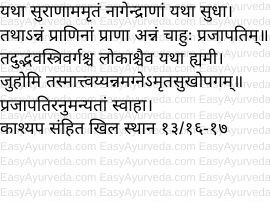Solid Food Feeding Ceremony: Annaprashana Samskara
By Dr Raghuram Y.S. MD (Ay) & Dr Manasa, B.A.M.S
Annaprashana Samskara comprises a ceremony in which solid food is fed for the first time to the child. This marks the change of food patterns for the child from liquid and semisolid to solid forms of foods. Actually the solid foods are introduced to the child in this ceremony. This will be celebrated amidst family and well wishers following all sacred rituals in the presence of priests and elders. The child henceforth would graduate from ‘only milk consuming’ state to ‘both milk and solid food consuming’ state.
Anna = solid food
Prashana = feeding
It is also during this phase that the tooth erupts in the children. It is also called Annaprasan Sanskar.
Read – Your Child Does Not Eat Well? Causes, Ayurveda Solutions

Table of Contents
Time
‘First feeding of solid food’ ceremony is usually conducted in the sixth month of the child’s life. Master Sushruta too has opined the same about the time of conducting this ceremony. On the contrary Master Kashyapa opines to give fruit juices to the child in the sixth month. He says that solid food shall be introduced to the child in the 10th month. Later, gradually the child should be put into practice of taking solid food from 12th month onwards. Master Kashyapa has given a detailed account of ‘solid food feeding ceremony’.
Solid food feeding ceremony as explained by Master Kashyapa
A wise physician should make arrangements to feed the child with various types of fruits in the 6th month in a ceremonious way.
Following this, once the child’s teeth have erupted solid food feeding ceremony shall be conducted in the 10th month, again in a ceremonious way. This shall be done on an auspicious day i.e Prajapatya / Rohini star constellation.
Read – Playground and Toys for Children As Explained In Ayurveda
Below mentioned rituals shall be conducted –
The Gods and Brahmanas should be worshipped with reverence.
Food mixed with meat should be enchanted with holy hymns along with coins.
On the other side a platform should be constructed specially for sacrificing the food. This platform should be anointed with cow dung paste. On this, a layer of darbha grass should be spread. Over this layer another layer of fresh jasmine flowers should be spread out.
On all sides of the platform, big pots filled with water decorated with fragrant materials and garlands and other auspicious materials and symbols should be placed at places meant and pre-designed for their placement.
After having arranged all the materials which had been mentioned in upaveshana i.e. seating ceremony of the child, any one of the meat of lava, tittira or cock and many other forms of well processed dishes and varieties of foods / edibles and drinks prepared with mind pleasing materials shall be kept at the center of the platform.
Seating the child – Physician should stand facing east and make the child sit facing the west direction. Before this, the child should have been decorated with jewelry and garlands, made to wear new dressing and should have been protected through rakshavidhana / auspicious protective measures.
Next the physician should ignite the sacred / sacrificial fire and give oblations of the food which has been kept ready on the platform along with various sacred symbols, materials and edibles by enchanting the below mentioned hymn –

Meaning of the hymn
‘Food is very important for human beings and their sustenance of life just like the nectar is for the Gods and sudha, the ultimate intoxicant is for the best elephants of the world. Food is itself called Prajapati, the guardian of creation. The food is also produced in the same way as are the Trivargas i.e. Dharma – righteousness, Artha – wealth and gains and Kama – desires and this world is created. Therefore, hey Lord of Fire, I am sacrificing within you this food which gives satisfaction and bliss like nectar. Please accept my oblation. May Lord Prajapati acknowledge my oblation and sacrifice..!’
Read – Symptoms That Hint Towards Different Diseases In Babies
Feeding solid food
After having offered a major part of the food as oblation to the fire as a part of sacrifice, a small quantity of remaining food should be taken and ground into soft paste. The child should be fed with this solid food for 3 to 5 times. After this, the child should be given sips of water to drink. This also allows the food to easily enter the stomach of the child.
Solid food after 12 months of age
After having introduced solid food in the 10th month as said above, slight changes shall be made in the quality and quantity of the food given to the child as he or she progresses into the 12th month of age.
At this age, when the child feels hungry, the below mentioned foods should be fed in small proportions.
Old rice and paddy grown in just 60 days – should be taken and their husk removed and fried in a pan. This rice should be washed thoroughly and cleansed. This rice should be properly cooked, smashed and made into paste, mixed with little ghee and salt, made into a form of confection and fed to the child. This form of food is easily digestible and nutritious to the child.
Use of barley and wheat – Once the child gets accustomed to rice; he shall be introduced with barley and wheat. Just like the rice, barley or wheat shall be smashed into soft paste and fed to the child.
Energetic and nourishing food – The confection prepared using Embelia ribes, rock salt and ghee is nourishing for children and should be given often.
If due to this formulation loose stools occur in the child, a small quantity of kodrava – Paspalum scrobiculatum should be added to the same food.
If excess of pitta is found, a mixture of raisins, honey and ghee shall be given to counteract the same.
If excess of vata is found, juice of Citron / Citrus medica mixed with rock salt is given.
The living place of the child (geography), the season, the digestive capacity of the child, the strength and tolerance of the child and other factors should be seriously taken into consideration to decide and determine the type of solid food, the dose / quantity of food and the number of times the food needs to be fed to the child.
Click to Consult Dr Raghuram Y.S. MD (Ayu)









